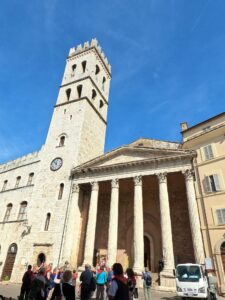
The Assisi of the Roman Empire
Assisi retains many references to its past as a Roman city such as the Temple of Minerva ![]() which was later acquired by Christianity and converted into a church. The exterior perfectly retains the appearance of a pagan temple as the six Corinthian columns supporting the structure are clearly visible, while all around it was incorporated into other structures built during the Middle Ages.
which was later acquired by Christianity and converted into a church. The exterior perfectly retains the appearance of a pagan temple as the six Corinthian columns supporting the structure are clearly visible, while all around it was incorporated into other structures built during the Middle Ages.
Inside you can see the original floor, which was brought back to light after spending decades hidden by one made in more modern times.
Also dating back to Roman times is the forum where Asisium is located underground and can be visited by paying an entrance fee to the site; here there are also two Domus Romane that have perfectly preserved their characteristics such as colourful frescoes, marble floors and other decorations that represent the prosperity enjoyed not only by the owners of the dwellings but, in general, by the people who lived in that city.
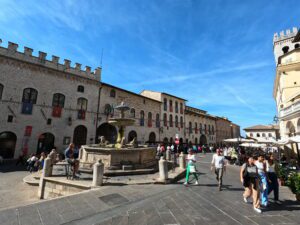
The Town Hall Square
In the Piazza del Comune (city hall square)![]() , the main historical centre of the city, is the Palazzo del Capitano del Popolo and the Palazzo dei Priori.
, the main historical centre of the city, is the Palazzo del Capitano del Popolo and the Palazzo dei Priori.
This area can be easily reached on foot no matter from which point you start because it is the heart of the city itself, in fact here stands the Torre del Popolo, which is the symbolic monument and one of the most eye-catching attractions since it is located next to the Temple of Minerva. When it was built, it served as the home of the Capitano del Popolo’s family.
The “Palazzo dei Priori” today houses the seat of the Town Hall, access is free and it is definitely worth a visit as it houses the Hall of Coats of Arms.
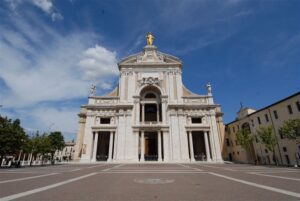
The Basilica of Santa Maria degli Angeli in Pornizucola
Once you have finished your visit to Assisi, you can leave the town for a while to reach another place linked to the cult of St Francis: the Basilica of Santa Maria degli Angeli in Porzincola ![]() , which is about 4 kilometres from the town centre and can be easily reached by bus.
, which is about 4 kilometres from the town centre and can be easily reached by bus.
There are several events that link the Saint’s life to this place. The first is the Porziuncola, a small church within the cathedral complex. Here, St Francis composed part of the ‘Hymn to the Creatures’, the oldest poetic text of which the author is known. As one of the first churches restored by St Francis, it was made the centre of Franciscanism.
A painful event is also linked to this place, namely the death of St Francis in 1226.
The Basilica of Santa Maria delle Angeli is definitely a place that cannot be excluded from a visit to Assisi, especially if the reason for going there is religious.
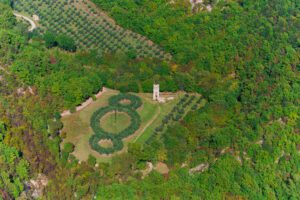
The Forest of St Francis
For all those who love nature, a visit to the “Bosco di San Francesco” (forest of St. Francis) ![]() is a must. It is easily reached on foot via a path that starts from the saint’s Basilica. The garden covers 64 hectares and inside there are different types of plants, a small church, a mill and a work created by Pistoletto and renamed ‘Third Paradise’, in which hundreds of olive trees are arranged to form three circles that join together.
is a must. It is easily reached on foot via a path that starts from the saint’s Basilica. The garden covers 64 hectares and inside there are different types of plants, a small church, a mill and a work created by Pistoletto and renamed ‘Third Paradise’, in which hundreds of olive trees are arranged to form three circles that join together.
Entrance to the Bosco is not free but requires payment of a ticket and web booking.
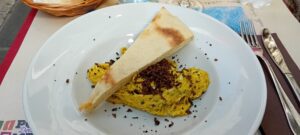 What to eat in Assisi
What to eat in Assisi
As mentioned at the beginning, Assisi is rich in culture, but not only from a historical and religious point of view, but also from a gastronomic one. In fact, there are several delicacies that you can taste in the typical restaurants in the centre during your visit.
Starting with breakfast, then moving on to lunch and dessert in the afternoon, Assisi will certainly not disappoint or leave you high and dry.
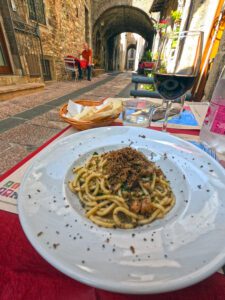
Typical dishes in Assisi
Assisi is famous for its pasta dishes, so on your tour of the city you cannot fail to stop and try Umbricelli, a homemade pasta that resembles spaghetti but is thicker and is seasoned with a tomato sauce enriched with pancetta, marjoram, garlic, grated pecorino cheese or onion.
Strangozzi are another type of pasta characteristic of the area and are very similar to fettuccine, these are generally seasoned with the famous Norcia truffle, porcini mushrooms or even asparagus.
Among the area’s most famous second courses are Anguilla del Trasimeno and Piccione alla Ghiotta; the former is a dish made from a fish caught in the waters of Lake Trasimeno and is stewed. Piccione alla Ghiotta (pigeon), on the other hand, is cooked entirely over embers and, once the meat is cooked, it is flavoured with a condiment prepared by combining all the meat juices that have spilled over the embers and pieces of offal.
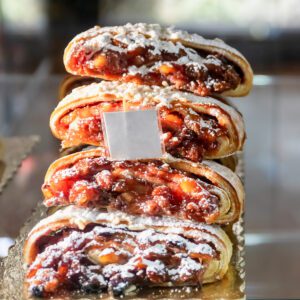
Favourite traditional desserts
The first dessert we want to tell you about is Rocciata, which has its roots in ancient traditions dating back to the Middle Ages. Its name is reminiscent of its shape, as it means ’round’, and it was prepared during the autumn and winter months due to the ingredients used. In fact, the inside is enriched with sultanas, pine nuts, apples, walnuts and almonds, while the outside dough is very similar to that of strudel.
Another well-known sweet are the Baci di Assisi (Assisi kisses), which are recognisable because, unlike the traditional Baci di Dama made of two biscuits, they are a single dough made of almond paste completely covered with almond petals; some versions also have an inner heart made of cream.
The last sweet we want to mention, but no less important, is the Ciaramicola, perfect as an end to a meal as it is a sweet doughnut soaked in Alchermes and covered with an icing made of egg whites and coloured sugared almonds; this sweet is often prepared during the Easter holidays.
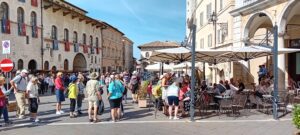 Nightlife in Assisi
Nightlife in Assisi
Assisi is a spectacular city from a cultural point of view, but it certainly cannot be counted among the places for nightlife.
In the centre there are several lounge bars and wine bars where you can have an aperitif or a drink after dinner in the company of friends, but the atmosphere in the streets of the town is very relaxing.
Just outside the town, however, there are some discos with DJ sets and live music to please even the youngest clientele.
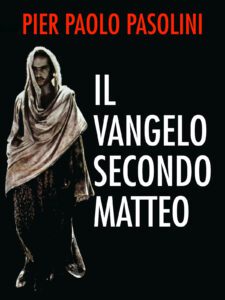 Curiosities about the city of Assisi
Curiosities about the city of Assisi
Let us take a look at some small curiosities about the city of Assisi that you may not know but that can enrich your visit even more.
Many of the women’s monasteries in the town were, during the Second World War, shelters for the Jews of the area that remained hidden undetected until the end of the conflict.
Director Pasolini conceived the film ‘Il Vangelo di Matteo’ (The Gospel of St. Matthew) while he was visiting Assisi; in fact, the original script of the work released in 1964 is still well preserved in the town.
Photo Credits: ©Wirestock/istock, ©Poli Foto/istock, ©Crisfotolux/istock, ©G.Miele/guidesmart
